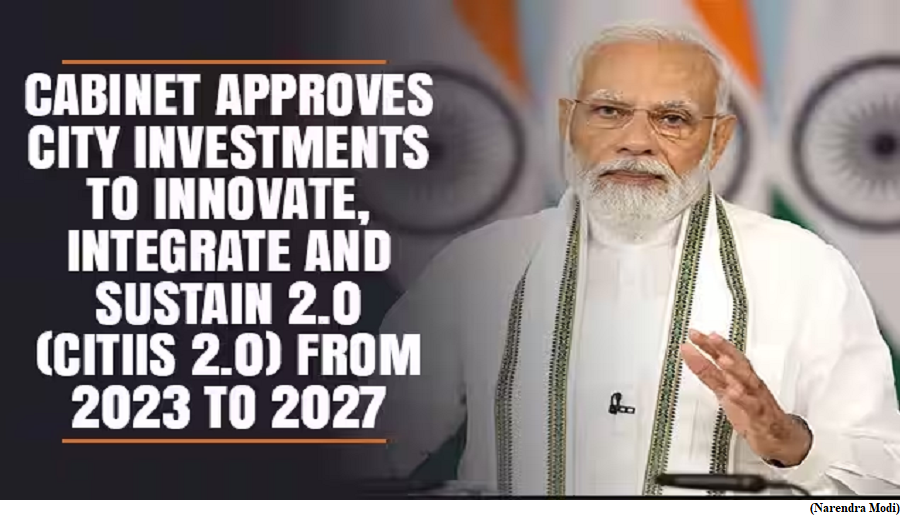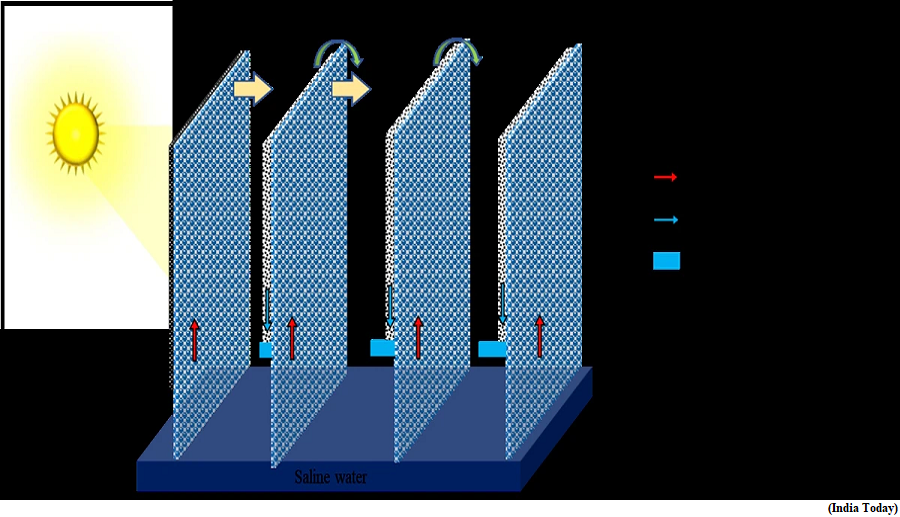Cabinet approves City Investments to Innovate, Integrate and Sustain 2.0 (CITIIS 2.0) (GS Paper 3, Economy)

Why in news?
- Recently, the Union Cabinet has approved the City Investments to Innovate, Integrate and Sustain 2.0 (CITIIS 2.0).
Details:
- CITIIS 2.0 is a program conceived by the Ministry of Housing and Urban Affairs (MoHUA) in partnership with the French Development Agency (AFD), Kreditanstalt für Wiederaufbau (KfW), the European Union (EU), and National Institute of Urban Affairs (NIUA).
- The program will run for a period of four years, i.e., from 2023 till 2027.
- The program envisages to support competitively selected projects promoting circular economy with focus on integrated waste management at the city level, climate-oriented reform actions at the State level, and institutional strengthening and knowledge dissemination at the National level.
- The funding for CITIIS 2.0 would include a loan of Rs.1760 crore (EUR 200 million) from AFD and KfW (EUR 100 million each) and a technical assistance grant of Rs.106 cr. (EUR 12 million) from the EU.
- CITIIS 2.0 aims to leverage and scale up the learnings and successes of CITIIS 1.0.
CITIIS 1.0:
- CITIIS 1.0 was launched jointly in 2018 by MoHUA, AFD, EU, and NIUA, with a total outlay of ₹933 crore (EUR 106 million).
CITIIS 1.0 consisted of three components:
- Component 1: 12 city-level projects selected through a competitive process.
- Component 2: Capacity-development activities in the State of Odisha.
- Component 3: Promoting integrated urban management at the national level through activities undertaken by NIUA, which was the Program Management Unit (PMU) for CITIIS 1.0
Following the CITIIS 1.0 model, CITIIS 2.0 has three major components:
Component 1:
- Financial and technical support for developing projects focused on building climate resilience, adaptation and mitigation in up to 18 smart cities through selection of competitively selected projects promoting circular economy with focus on integrated waste management.
Component 2:
- All States and UTs will be eligible for support on demand basis. The States will be provided support to
- set-up/strengthen their existing State climate centres/ Climate cells/ equivalents
- create State and city level Climate Data Observatories
- facilitate climate-data driven planning, develop climate action plans and
- build capacities of municipal functionaries.
- To achieve these objectives, the PMU at NIUA will coordinate provision of technical assistance and strategic support to State Governments.
Component 3:
- Interventions at all three levels; Centre, State and City to further climate governance in urban India through institutional strengthening, knowledge dissemination, partnerships, building capacity, research and development to support scale up across all States and Cities.
Way Forward:
- CITIIS 2.0 will supplement the climate actions of Government of India through its ongoing National programs (National Mission on Sustainable Habitat, AMRUT 2.0, Swachh Bharat Mission 2.0 and Smart Cities Mission), as well as contributing positively to India’s Intended Nationally Determined Contributions (INDCs) and Conference of the Parties (COP26) commitments.
World’s Largest Grain Storage Plan in Cooperative Sector
(GS Paper 3, Economy)
Why in news?
- Recently, the Union Cabinet approved the constitution and empowerment of an Inter Ministerial Committee (IMC) for facilitation of the “World’s Largest Grain Storage Plan in Cooperative Sector” by convergence of various schemes of the Ministry of Agriculture and Farmers Welfare, Ministry of Consumer Affairs, Food and Public Distribution and Ministry of Food Processing Industries.

Pilot Project:
- The Ministry of Cooperation will implement a pilot project in at least 10 selected Districts of different States/ UTs in the country.
- The Pilot would provide valuable insights into the various regional requirements of the project, the learnings from which will be suitably incorporated for the country-wide implementation of the Plan.
Implementation
- An Inter-Ministerial Committee (IMC) will be constituted under the Chairmanship of Minister of Cooperation, with Minister of Agriculture and Farmers Welfare, Minister of Consumer Affairs, Food and Public Distribution, Minister of Food Processing Industries and Secretaries concerned as members to modify guidelines/ implementation methodologies of the schemes of the respective Ministries as and when need arises, within the approved outlays and prescribed goals, for facilitation of the ‘World’s Largest Grain Storage Plan in Cooperative Sector’ by creation of infrastructure such as godowns, etc. for Agriculture and Allied purposes, at selected ‘viable’ Primary Agricultural Credit Societies (PACS).
- The Plan would be implemented by utilizing the available outlays provided under the identified schemes of the respective Ministries.
Following schemes have been identified for convergence under the Plan:
Ministry of Agriculture and Farmers Welfare:
- Agriculture Infrastructure Fund (AIF),
- Agricultural Marketing Infrastructure Scheme (AMI),
- Mission for Integrated Development of Horticulture (MIDH),
- Sub Mission on Agricultural Mechanization (SMAM)
Ministry of Food Processing Industries:
- Pradhan Mantri Formalization of Micro Food Processing Enterprises Scheme (PMFME),
- Pradhan Mantri Kisan Sampada Yojana (PMKSY)
Ministry of Consumer Affairs, Food and Public Distribution:
- Allocation of food grains under the National Food Security Act,
- Procurement operations at Minimum Support Price
Benefits of the Plan:
- The plan is multi-pronged – it aims to address not just the shortage of agricultural storage infrastructure in the country by facilitating establishment of godowns at the level of PACS, but would also enable PACS to undertake various other activities, viz:
- Functioning as Procurement centres for State Agencies/ Food Corporation of India (FCI);
- Serving as Fair Price Shops (FPS);
- Setting up custom hiring centers;
- Setting up common processing units, including assaying, sorting, grading units for agricultural produce, etc.
- Further, creation of decentralized storage capacity at the local level would reduce food grain wastage and strengthening food security of the country.
- By providing various options to the farmers, it would prevent distress sale of crops, thus enabling the farmers to realise better prices for their produce.
- It would hugely reduce the cost incurred in transportation of food grains to procurement centres and again transporting the stocks back from warehouses to FPS.
- Through ‘whole-of-Government’ approach, the Plan would strengthen PACS by enabling them to diversify their business activities, thus enhancing the incomes of the farmer members as well.
Time-frame and manner of implementation:
- National Level Coordination Committee will be formed within one week of the Cabinet approval.
- Implementation guidelines will be issued within 15 days of the Cabinet approval.
- A portal for the linkage of PACS with Govt. of India and State Governments will be rolled out within 45 days of the Cabinet approval.
- Implementation of proposal will start within 45 days of the Cabinet approval.
Indian researchers develop new system to purify water
(GS Paper 3, Science and Technology)
Why in news?
- As the world faces the growing challenge emerging from water scarcity, a new system developed by researchers from the Indian Institute of Science (IISc) could help increase water availability.
- The innovative thermal desalination system operates using solar energy and could potentially increase the availability of clean, drinkable water in areas facing water shortages.

Thermal desalination:
- Thermal desalination is a unique process used to clean water that involves removing salt and other impurities from water by using heat to evaporate the water and then condensing the resulting vapor to obtain fresh water.
- The heat can be generated using various energy sources such as electricity, fossil fuels, or renewable energy like solar power.
Key features:
- They developed a design for a solar-powered desalination unit that is more energy-efficient, cost-effective, and portable.
- It uses the same working design as solar stills in which solar energy is employed to evaporate saltwater in large reservoirs and the vapour that condenses on a transparent roof is collected.
- The new system is convenient to set up in areas with limited access to continuous electricity and is composed of a reservoir of saline water, an evaporator, and a condenser enclosed within an insulating chamber to avoid heat losses to the ambient air.
How it works?
- Solar thermal energy evaporates a small volume of water wicked into the evaporator, which features a textured surface. The capillary effect of microscale textures enables the liquid to be drawn into narrow spaces of the evaporator, improving the system's energy efficiency.
- To prevent the formation of a water film during condensation, they designed a condenser with alternating hydrophilic and superhydrophobic surfaces.
- The system is designed to trap and utilize the heat released during condensation, further reducing the amount of solar energy required. This heat is used to warm up the saltwater in a separate evaporator located behind the condenser, enhancing the system's efficiency.
- They designed the system in a way that it can be adjusted to align with the sun's shifting positions during the day, and it can effectively desalinate seawater, groundwater with dissolved salts, and brackish water.
Way Forward:
- The team is focused on scaling up the system, improving its durability, and incrasing the volume of drinking water produced.




